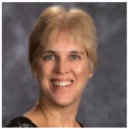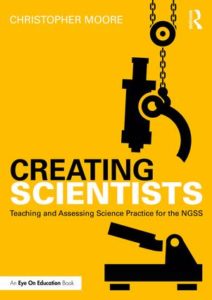Creating New Scientists: Teaching with the NGSS
Creating Scientists: Teaching and Assessing Science Practice for the NGSS
By Christopher Moore
(Routledge/Eye On Education, 2018 – Learn more)

I liked the approach that author Christopher Moore uses in the opening chapter of Creating Scientists. He introduces the idea that “creating scientists” should be the goal of any good science teacher and also the goal of the Next Generation Science Standards (NGSS).
Moore helps readers better understand the reasoning behind the NGSS and how to bring their challenging vision to life in our classrooms. If teachers focus science lessons with his goals in mind, students will benefit.
Making science personally relevant to students

Too many students have the misconception that science is mostly a collection of memorized facts with absolute validity and no room for expansion. This finding is disappointing to say the least. Sure, I want my students to know science facts, but I value more their ability to problem solve and to think of science as a process to do that.
The author encourages teachers to make science more personally relevant by approaching science teaching in ways that are similar to the way scientists practice science. Investigations, interpretation, and communication are listed as the critical aspects of the science process. There is a flow chart on page 24, Figure 1.2 (and again on page 179, Figure 7.8) that assists the reader in visualizing how scientists actually practice science.
Several helpful examples of student work and scoring rubrics are also in this section of the book. Use of the NGSS Performance Expectations and Evidence Statements are evident in the design of lessons and the related assessments.
Techniques to transform classrooms
Part II provides teachers with techniques to transform their classrooms aligning to the NGSS and to the science practice of investigation. Teachers are again challenged by the author to think about science content and the ways it is presented from the viewpoint of students. Examples of students constructing their own knowledge under their teachers’ guidance are provided. I also liked the teaching tips that were shared such as having representatives of groups present during a class “conference.”
The NGSS Appendices are discussed in this section of the book, showing the reader the progressions of learning in K-12 science. Readers are reminded that the NGSS is not a curriculum but a minimum set of standards. To help “strengthen student understanding about a topic,” teachers are encouraged to expand upon the content and practices in the NGSS. I would warn to do that discriminately so that we are not back to the “mile wide and inch deep” approach of the past.
Part II attempts to put all parts together by sharing an example capstone project. A good capstone (page 169) reinforces learned material, has students using practices in new ways and promotes students’ expert-like views about science. The Black Box Light Bulb Capstone includes examples of student notebook entries and gives many suggestions for a successful project.
I noted a few places where those who are familiar with NGSS terminology may need to differentiate how words such as “dimension” and “practices” are used. Like all new books, there are a few typos, but they do not alter the meaning of the content. I would suggest an exemplary column be added to the rubrics.
I liked Christopher Moore’s relaxed writing style; it made this book an easy read. It is impossible to provide everything in one source that a teacher might need, but if possible more actual examples of activities would be appreciated. Those that were included have been classroom tested.
I think there are some valuable suggestions and explanations included in Creating Scientists: Teaching and Assessing Science Practice for the NGSS for teachers. If students begin to more closely think like scientists, it will be amazing to watch what they can accomplish. It is what we hope for!
For more than 39 years Joyce Depenbusch has been involved in education in one way or another. In elementary and middle school classrooms and as the wildlife education coordinator for Kansas, she has combined her love of children and nature. Currently, she is a middle school science teacher in rural south-central Kansas. Joyce enjoys presenting at workshops about ways to implement the NGSS and spending time on the family farm. She serves on state and national committees about science education.


































